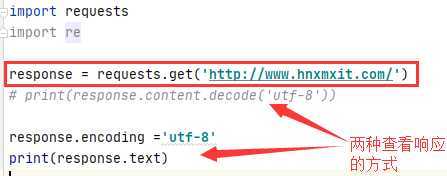方式一:执行 pip install -U requests 联网安装requests
方式二:进入https://pypi.org/project/requests/,下载并解压requests-***.tar.gz,然后用cmd进入解压目录,使用命令Python setup.py
import requests
response = requests.get(‘http://www.hnxmxit.com/‘)
# print(response.content.decode(‘utf-8‘))
response.encoding =‘utf-8‘
print(response.text)

import requests
get_param_data={
‘grant_type‘:‘client_credential‘,
‘appid‘:‘wxb9013645f9c6f66b‘,
‘secret‘:‘8c80367d3fac3cb6d3dc910fe6416436‘
}
response = requests.get(‘https://api.weixin.qq.com/cgi-bin/token‘,get_param_data)
# print(response.content.decode(‘utf-8‘))
print(response.json()[‘access_token‘])

import requests
get_param_data = {‘wd‘:‘你好‘}
headinfos = {
‘User-Agent‘:‘Mozilla/5.0 (Macintosh; Intel Mac OS X 10_13_6) AppleWebKit/537.36(KHTML, like Gecko) Chrome/68.0.3440.106 Safari/537.36‘,
‘Accept-Encoding‘:‘gzip,deflate,br‘,
‘Accept-Language‘:‘zh-CN,zh;q=0.9‘,
‘Accept‘:‘text/html,application/xhtml+xml,application/xml;q=0.9,image/webp,image/apng,*/*;q=0.8,application/signed-exchange;v=b3;q=0.9‘
}
response = requests.get(url=‘https://www.baidu.com/s‘,params=get_param_data,headers=headinfos)
print(response.content.decode(‘utf-8‘))

Post 请求的请求参数是通过data方式来传递的。Post的请求参数一般有form表单(使用dict类型传输)、json数据、文件等。
1)form表单:(新建用户标签)
import requests
import json
get_param_data ={‘access_token‘:‘33_cmNwYXdi1m3_bCbx2Y3jhvTsBGWNol_jVVy7X8tJ4kSn4M9vc33TlKfCjWFoClH8Qkt_dhagALj1T4IVlhnR8H7mz65HJTNwDWpAG4I4Gk7OGq1VSuyXhq2NRjnqWACqoPBSDmxnphzSocpMDZKjADAXTE‘}
post_param_date = { "tag" : { "id" : 100, "name" : "广东人人" } }
headinfos = {‘Content-Type‘: ‘application/json‘} #发送json数据必带的头部信息
reponse = requests.post(url=‘https://api.weixin.qq.com/cgi-bin/tags/update‘,
params=get_param_data,
data=json.dumps(post_param_date),
headers=headinfos)
print(reponse.content.decode(‘utf-8‘))

2)Json数据:
方式一: (需要使用json模块)
jsonParams = {‘key‘: ‘value‘}
headers = {‘Content-Type‘: ‘application/json‘}
postJsonResponse = requests.post(url, headers=headers,data=json.dumps(jsonParams))
方式二:
jsonParams = {‘key‘: ‘value‘}
headers = {‘Content-Type‘: ‘application/json‘}
postJsonResponse = requests.post(url, headers=headers,json=jsonParams)
3)文件上传:
import requests
# 简单处理
excel_file ={‘file‘:open(‘file1.xlsx‘,‘rb‘)}
# 显式地设置文件名,文件类型和请求头:(文件名,文件的打开方式,文件头信息,文件有效期)
# excel_file ={‘file‘:(‘file1.xlsx‘,open(‘file1.xlsx‘,‘rb‘),‘application/vnd.ms-excel‘,{‘Expires‘: ‘0‘})}
file_response = requests.post(‘http://httpbin.org/post‘,files=excel_file)
print(file_response.content.decode(‘utf-8‘))
import json
str_dict={‘name‘:‘xiaoming‘,‘age‘:22}
str1 = json.dumps(str_dict) # josn-->字符串
str2 =json.loads(str1) # 字符串 --》字典
print(str2[‘age‘])
解析json数据
import jsonpath
str_value = ‘{"tags":[{"id":2,"name":"星标组","count":0},{"id":100,"name":"广东人","count":3},{"id":101,"name":"湖南","count":0},{"id":103,"name":"test001","count":0},{"id":183,"name":"测试05-29-hello_01","count":0},{"id":184,"name":"测试05-29-hello_02","count":0},{"id":185,"name":"测试05-29-hello_03","count":0},{"id":186,"name":"测试05-29-hello_04","count":0},{"id":187,"name":"测试05-29-hello_05","count":0}]}‘
json_data = json.loads(str_value) #josn对象
value = jsonpath.jsonpath(json_data,‘$.tags[1].name‘)
print(value,value[0])
输出:

【python之requests模块使用01】安装、模拟get/post请求,jsonpath解析json数据
原文:https://www.cnblogs.com/xiaoshijie/p/13056644.html